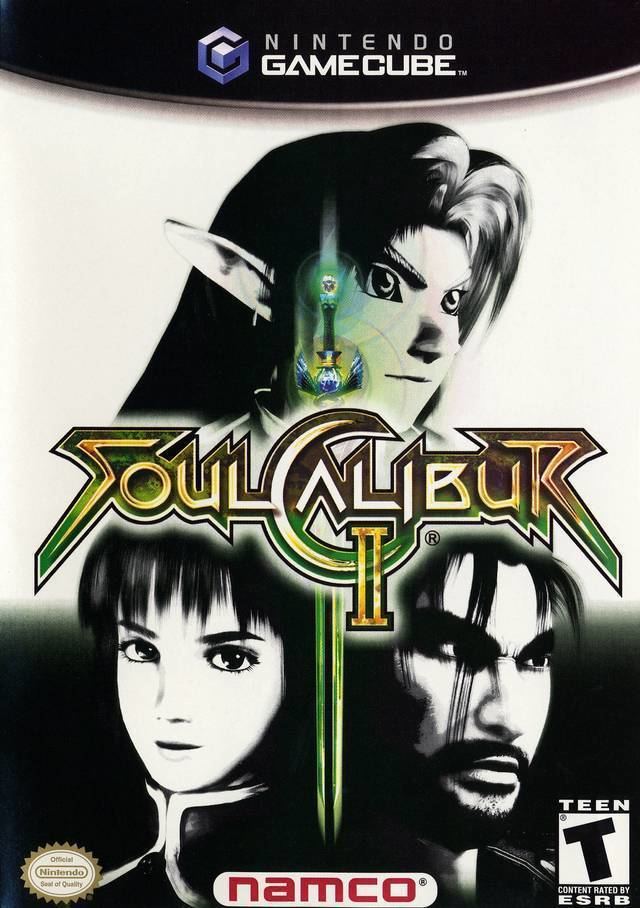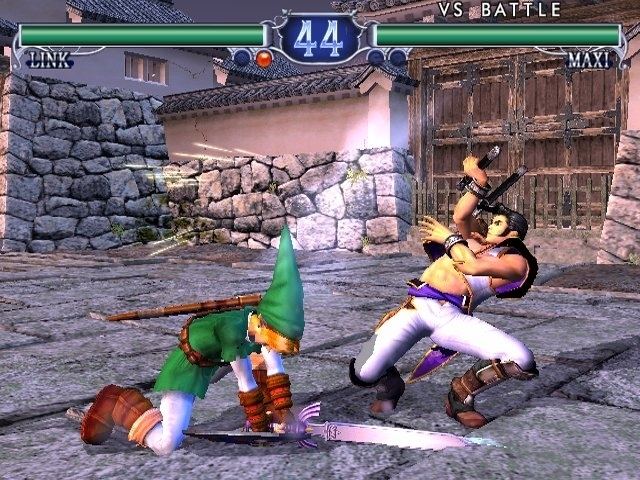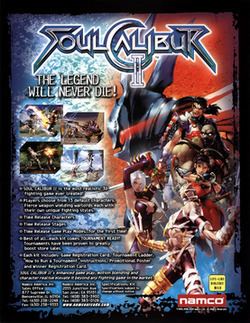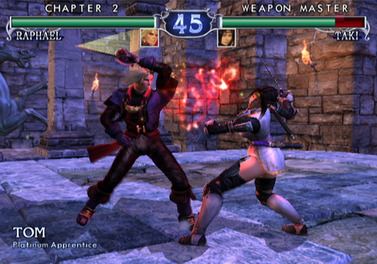9 /10 1 Votes
4.5/5 Emuparadise Developer(s) Project Soul Programmer(s) Shinobu Nimura Initial release date 5 July 2002 | 9.2/10 IGN 8.5/10 GameSpot Producer(s) Hiroaki Yotoriyama Artist(s) Ryoichi Ban Designer Hiroaki Yotoriyama | |||||||||||||||||||||||||||||||||
 | ||||||||||||||||||||||||||||||||||
Director(s) Jin OkuboYoshitaka Tezuka Awards VGX Award for Most Addictive Video Game, BAFTA Games Award for Animation or Intro Similar Soulcalibur games, Namco games, Fighting games | ||||||||||||||||||||||||||||||||||
Soulcalibur ii game grumps vs
SoulCalibur II (ソウルキャリバーII, Sōrukyaribā Tsū) is a 2002 fighting video game developed by Project Soul and published by Namco and the third installment in the Soulcalibur series of weapon-based fighting games. It is the sequel to Soulcalibur, which was released in July 1998. Originally intended to be released on Sega's NAOMI board, the game was released on the Namco System 246 arcade board before being ported to the PlayStation 2, GameCube, and Xbox in 2003. The game's plot revolves around an assortment of characters, each with the goal of either destroying Soul Edge or obtaining it to achieve personal goals. Compared to Soulcalibur, Soulcalibur II had improvements in graphics and the game system and introduced several new and guest characters.
Contents
- Soulcalibur ii game grumps vs
- Gameplay
- Characters
- Plot
- Release
- SoulCalibur II HD Online
- Reception
- References

The game was a major critical and commercial success. Its high-definition port, titled SoulCalibur II HD Online, was released for the PlayStation 3 and Xbox 360 in 2013.

Gameplay

Key game system improvements include an easier "step" and "avoid" systems, arena walls (rather than ring-out ability on all sides) and wall-specific moves, a three-step Soul Charge system, a clash system that is used when two attacks would hit each other resulting in a white flash, Guard Break attacks which put a blocking player into a post guard-impact state, just frame moves awarding additional hits to players who could time their command inputs well, and a revised Guard Impact system that removed height-based Impact moves and instead used a more unified system (high and mid attacks are countered using Repels, mid and low attacks are countered using Parries).

SoulCalibur II presents the normal modes from most fighting games: Arcade, Team Battle Mode (similar to arcade, but with teams of up to eight characters and without cutscenes or endings), Time Attack (fight against the clock to gain records), Survival Battle, and Training Mode. There are also "Extra" versions of these modes, intended to allow the use of the Extra Weapons. Each character has one according to their story, and are shared by groups of two (for example: Mitsurugi → Taki, Taki → Mitsurugi) with the exception of the console-exclusive characters. As in SoulCalibur, there is a "Museum", containing character artwork, various videos (like Arcade Intro or WMM intro and Ending) and Weapon Exhibition. There is also the "Profile Viewer" (to see character's stories) and "Battle Theater" (to see CPU vs CPU battles).
A returning feature from Soul Edge is the inclusion of extra weapons. Instead of Soul Edge's system of different stats, this one is based on power %, defense % and special abilities (drains energy, pass through defense, etc.). Each character has 12 different weapons, from the standard (basic) weapons for 1P and 2P to the powerful "Ultimate Weapon". Each character was granted a Soul Edge version of their arms and a "Joke Weapon" with bad stats and effect, with unique and funny hit sounds. Each weapon is given a backstory in the "Weapon Gallery". Like before, some characters are granted with a third costume, purchased in Weapon Master Mode. Out of the 25 selectable characters, 13 were granted a third costume: Astaroth, Cassandra, Ivy Valentine, Mitsurugi, Nightmare, Raphael, Seung Mina, Sophitia, Taki, Talim, Voldo, and Xianghua. The GameCube version's guest character Link has four costumes (green, red, blue, and lavender) and Assassin, Berserker, and Lizardman each have six different costumes (three color edits of their two standard costumes).
The Arcade version has a unique mode called "Conquest Mode" that allows the player to pick an army, fight enemies and gain experience points, allowing it to increase the level of the selected player. "Weapon Master Mode", made in a similar fashion to Soul Edge's "Edge Master Mode" and Soulcalibur's "Mission Mode", takes the core system from "Conquest Mode" and expands upon it. This mode presents a history set in an alternate world, while the player moves in a map divided in "regions" (named after stars) and fights enemies to gain experience points (which raises the "rank" of the character) and money (which can be used to buy weapons, art, costumes and videos). The mode has 10 normal chapters, four sub-chapters and two extra chapters as well as Extra-Missions (alternate version of normal missions). The plot of the mode puts the player into the role of a swordsman searching for Soul Edge, who suddenly is faced against a powerful mad knight named Veral (who takes the form of Nightmare, then Inferno), searching for Soul Edge for his own desires.
Characters
Four new playable characters were introduced in SoulCalibur II: Cassandra (fighting styles derived from Sophitia), Raphael (unique fighting style), Talim (unique fighting style), and Yunsung (fighting style derived from Hwang).
A new unlockable character Charade, like its predecessors Edge Master and Inferno, switches its style to match existing characters' move lists with each individual round of fighting. The home versions of the game feature Necrid, a new character created by Todd McFarlane, and one of three platform-exclusive characters: Heihachi Mishima from Tekken on the PlayStation 2, Link from The Legend of Zelda on the GameCube and Spawn from the comic book series by McFarlane on the Xbox. The HD version includes both Heihachi and Spawn.
Fully returning as playable characters are Astaroth, Cervantes, Ivy, Kilik, Maxi, Mitsurugi, Nightmare, Seung Mina, Sophitia, Taki, Voldo, Xianghua, and Yoshimitsu. Inferno is in the game, but it is not a playable character. Nightmare's third costume is Siegfried (though he is still referred to as Nightmare), while the Assassin and Berserker play extremely similar to Hwang and Rock, who did not return from the original Soulcalibur. Lizardman returns, but is only playable in VS Mode and certain portions of Weapon Master.
Plot
The game is set in the year 1591, four years after the events of Soulcalibur. The wave of slaughters that terrorized Europe reached a sudden end. The knight in azure armor, Nightmare, and his followers were successful in collecting enough souls and were about to start the restoring ceremony on the ruins of the once-proud Ostreinsburg Castle. But just as the ceremony was to start, three young warriors assaulted the castle. After an intense battle Nightmare fell, but then the evil soul inside Soul Edge sent the young warriors into a vortex of hellfire and stood to confront them. As a result of Soul Edge's evil aura, Krita-Yuga revealed its true form: that of the Holy Sword, Soul Calibur. The intense battle ended with the victory of the holy sword, but at the collapse of the vortex of Inferno, both swords along with the azure Nightmare were sucked in a void and expelled in another place. Siegfried, recognizing his sins, set out on a journey of atonement. Still the blade held a strong bond, and every night it took control of the body and took souls of those nearby. The efforts made by the young knight were fruitless, and four years later the Azure Knight Nightmare returned. Around those times various warriors came into contact of the blade's remaining fragments, revealing Soul Edge's ultimate survival after its defeat. Driven either to possess or destroy it, they join a new journey, while Nightmare begins his rampage, seeking souls to restore Soul Edge once again.
Release
A soundtrack for the game was released as Soulcalibur II Original Soundtrack. An art book was also published.
SoulCalibur II HD Online
A high-definition version of the game, titled SoulCalibur II HD Online, was released digitally for PlayStation 3 through PlayStation Network and Xbox 360 through Xbox Live in North America and Europe on November 19 and 20, 2013, respectively, and in Japan on February 20, 2014. It includes all game modes from the original releases, as well as support for online only gameplay over PlayStation Network and Xbox Live, respectively. For reasons unknown, the English version of the HD re-release lacks the dual-language option available in the original game and only features English voice acting. Both versions of the game also include two guest characters, Heihachi Mishima and Spawn, who were previously exclusive to specific platforms (PlayStation 2 and Xbox, respectively). In addition, in Japan, having the game data allows two virtual items and a costume available for free in Soulcalibur: Lost Swords.
Reception
The original version of SoulCalibur II received critical acclaim, earning it the average scores of 91.3% for the PlayStation 2, 92.3% for the GameCube, and 91.6% for the Xbox.
In the first ever Spike Video Game Awards in 2003, SoulCalibur II won in the category Most Addictive Game. In 2011, Complex ranked it as the 14th best fighting game of all time.
As of 2007, the GameCube version sold about a million copies in the US, and 100,000 in Japan, making it one of the best-selling third-party GameCube games.
